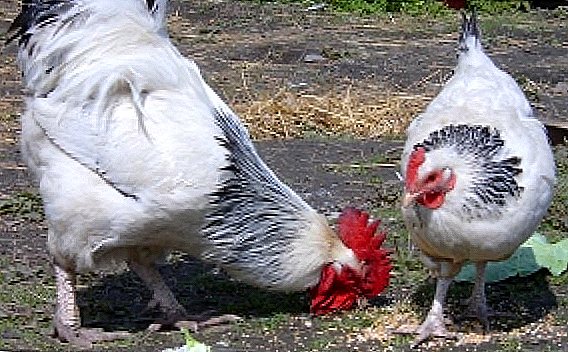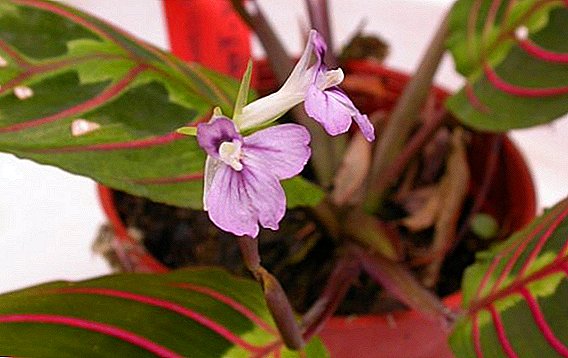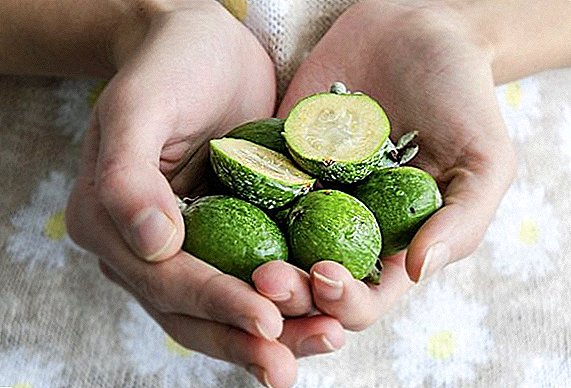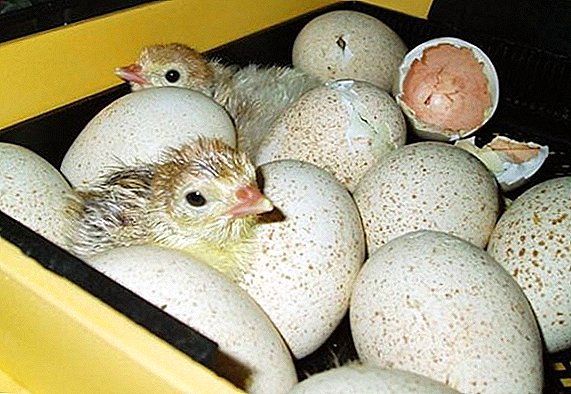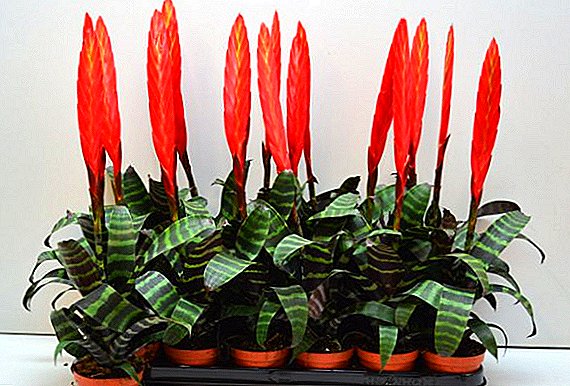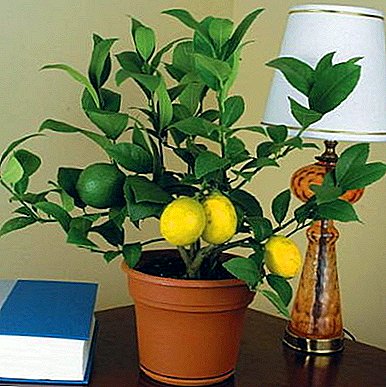
Lemon has long and reliably gained popularity and respect among the room growers. One of the best varieties of lemon, which is especially valued for its large fruits, is Lemon Kiev.
It can become not only an excellent decoration of your home, but will also long delight you with its tasty and healthy fruits, if you follow the rules of caring for it.
In addition, the leaves of the lemon tree are able to emit phytoncides that benefit the human body, purifying the air from pathogenic bacteria.
In this article we will talk about what this plant is, how to care for it, what diseases and pests can threaten it.
Homeland plants
Lemon Kiev Krupnoplodny was bred in 1994 in Kiev. The author of this variety was the Ukrainian breeder A.V. Patiy. This lemon variety was developed for a mid-latitude climate. it is unpretentious and great for growing lemon tree at home (in the apartment, greenhouse, winter garden).
Description
Lemon trees of the Lemon Krupnoplodny variety live up to sixty years. They usually start blooming when they reach one year old. These trees are distinguished by an average height of 2.5 meters and a thick lush green crown.
Lemon can bear fruit up to 4 times a year, therefore it is considered a high-yielding variety. Its fruits usually ripen from six to nine months, after which they can hang on the branches for up to three years, decorating the tree. The average weight of the fruit - from 500 to 700 grams, but individual copies can reach one and a half kilograms.
Fruits can be located on the branches in clusters and separately. They are covered with bright yellow skin, which by spring may become slightly greenish and turn yellow again by autumn.
Fruits of Lemon Kiev is great for use in cooking.
A photo



In general, the types of lemon, successfully grown in indoor conditions, there are many. These, in addition to Kiev, include the following: Meier, Pavlovsky and Panderoz.
 In addition to such an "exotic" as a lemon tree, other fruit crops are also grown at home.
In addition to such an "exotic" as a lemon tree, other fruit crops are also grown at home.We offer you detailed information about growing in an apartment and caring for Mango and Finikom.
Home care
Caring for a lemon room may seem very difficult for a beginner. But, in principle, it is enough to follow the basic rules.
After the purchase
Buying a lemon tree, pre-determine the place where it will stand. Remember that these plants are extremely difficult to carry various permutations and changing places. If, after the purchase, he begins to dump the leaves - so he reacts precisely to a change of place and conditions.
After buying the tree you need to transplant in a pot. Experience shows that the plant will feel best in a clay pot. For an annual lemon, a pot size of 0.5-1 liters is suitable; for a two-year-old, pots of 1-2 liters should be used. The earth lump is saved, the transshipment method is used.
In order to minimize stress and its consequences, the plant can be covered with a glass bell, put in a bright place and aerated from time to time.
Lighting
 Proper lighting is an important factor in the proper growth and development of lemon. He loves sunshine, but he cannot be in the direct rays of the sun.
Proper lighting is an important factor in the proper growth and development of lemon. He loves sunshine, but he cannot be in the direct rays of the sun.
The window to the east or west side of your room will be the best place to put a lemon pot..
In the summer, it should be moved away from the window into the room or provide him with a canopy from the sun. So that the tree does not grow one-sided, it must be rotated from time to time. Although this inhibits the growth process, the plant will be beautifully shaped. Every 2 weeks, rotate the plant at a small angle.
For lemon, both the lack of lighting and its oversupply are harmful. In the first case, the crown of the tree will be poor, and the fruit - too sour. In the second case, the plant may suffer from sunburn.
In winter, the lemon does not interfere with daytime illumination with a fluorescent lamp for 5-6 hours. The light source which is placed at a height of 60-80 cm above the plant.
Temperature
To ensure the optimum temperature for growing Kiev you should maintain the temperature of the air in the room where it grows, within 15-20 degrees Celsius.
In the summer, it will best grow at a temperature of 18 to 20 degrees, since it is this temperature that is most favorable for flowering and fruit set. The plant can be taken to fresh air, but you can not expose it to a sharp temperature dropas it can shed its leaves.
In winter, it should be kept at a temperature of 12 to 15 degrees Celsius. Being in a cool, bright room will have a beneficial effect on the fruiting tree. Lemon damage is a long stay in a room with air temperatures below 10 or above 25 degrees Celsius.
Air humidity
In summer, to maintain a comfortable humidity, lemons should be constantly sprayed with water. In winter, this should be done if the plant is located in a room with centralized heating.
You can periodically place the plant and under a warm shower, not allowing the pot to be poured with water. The most preferred air humidity for lemons is humidity in the range of 60-70%.
Lack of air humidity can trigger pests. To maintain the required humidity, you can place a lemon pot on a pallet with moist expanded clay or gravel.
Watering
Citrus love water. For irrigation use warm boiled or separated during the day water. The procedure is carried out twice a week in the summer and once a week in the winter.
Do not forget to ensure that the clod of land in which your lemon grows does not dry, as this can lead not only to the falling of the leaves, but also to the fruits themselves. But an overabundance of moisture is harmful to lemon.
In autumn, watering should be gradually reduced. To prevent water from stagnating in the pot, it is necessary to periodically break through the top layer of soil.
Bloom
 After the first year of his life, Kievsky will begin to delight you with his fragrant flowers. However in order that he began to bear fruit, it is necessary to prune it.
After the first year of his life, Kievsky will begin to delight you with his fragrant flowers. However in order that he began to bear fruit, it is necessary to prune it.
The fruits are tied on the branches of the fourth or fifth order, which grow in the second or third year of life.
In order for the tree to develop properly, in the third year of its life, it is necessary to remove half of the flowers and leave no more than three or four fruits from the ovaries. Next year you can leave five or six fruits, and then seven or eight.
Fertilizers
Lemons need fertilizer somewhat more often than other plants. In the summer, fertilizing should be carried out once a week, and in winter it is sufficient once a month.
The best fertilizer is Biohumus. Ten grams of this fertilizer must be dissolved in one liter of water, which must then be used to water the plant.
Chemical fertilizers are undesirable because they can damage the root system..
To nourish the plant with vitamins, add one tablespoon of ash per liter of constant water, mix well and pour lemon with this solution no more than once a week.
Such natural fertilizer as fish broth is also quite effective.
To cook it, boil two hundred grams of fresh fish in two liters of water for thirty minutes, and then leave to infuse for fifteen minutes. The resulting fish broth must be drained and cooled, and then add it one tablespoon to one liter of water for irrigation.
Transfer
Young trees need to be repotted every year. It is possible to start transplanting only when the roots of the plant are surrounded by a soil ball. If this has not happened yet, then a drainage and upper layer of the earth will be enough for a lemon.
You can replant grown-up lemons once in two or three years, trying not to destroy the earthen room too much. Keep the root neck at the same level as before the transplant.
You can not replant the lemons during their flowering or fruiting, as this will inevitably lead to the fall of flowers and fruits.
With regard to the composition of the soil, for young trees should be taken two parts of turf and one part of leafy land, as well as one part of sand and one part of humus from cow manure. For mature trees it is necessary to use three parts of sod land, some oily clay, one part of leafy earth and one part of sand and humus.
Watch a useful lemon transplant video:
Landing
Initially, planting should be carried out in a small pot, and as it grows, it is necessary to transplant it into a larger pot.
If you plant a small tree in a large pot, then that land that will not be occupied by roots, will sour. The diameter of each next pot for transplanting should be five to seven centimeters larger diameter of the previous pot.
For planting should choose a pot, the diameter and height of which do not exceed ten to fifteen centimeters. Best of all, it is made of clay. The bottom of the pot must be equipped with holes. First, drainage is laid on the bottom, in which quality you can use expanded clay or charcoal, which is covered with wet river sand.
This is done so that the upper ground does not fall into the drainage. Land for planting should be mixed in a bowl with a small amount of water. You will get a mass of sour cream density, which can fill the entire volume of the pot and will not leave air voids near the lemon roots.
When planting, the root neck of a lemon should be dug into the soil by no more than five millimeters.and the earth should not reach the edge of the pot 10 millimeters. This will protect the root collar from rotting and wetting, as well as prevent the soil from being washed off when watering the walls of the pot.
 Growing ornamental deciduous plants in an apartment is a very exciting activity. Moreover, their diversity gives the florist greater freedom of choice.
Growing ornamental deciduous plants in an apartment is a very exciting activity. Moreover, their diversity gives the florist greater freedom of choice.We suggest that you familiarize yourself with detailed information about such as Avocados and Bananas.
Growing problems
 When growing lemons, you may encounter some difficulties.
When growing lemons, you may encounter some difficulties.
If you notice that old lemon leaves began to turn yellow and fall off, and new ones are much smaller than before, and flowering and fruiting are not observed at all, you should be wary.
It means that your plant is in dire need of nutrients. The best solution to this problem will be transplanting lemon into the nutrient soil.
If the leaves began to fall off suddenly, it can be caused by many reasons.
Among the most common are insufficient lighting or low air temperature in the winter season, an overabundance of moisture in the soil, the use of cold water when watering, a lemon in a draft, and an excess of nutrients in the soil.
If you notice that yellow spots appeared on the leaves, or their edges turned yellow, and the leaves began to fall prematurelyThis may indicate that you too often or too abundantly water the lemon.
The same can happen in the case of irregular watering of the plant, when it gets a lot, then a little liquid.
Diseases and pests
The most common pests are scale insects and spider mites.
- Shchitovka.
On the defeat of the plant with flaps signal plaques of brown color, located on the surface of the leaves and the stem. At the same time, the leaves, flowers and fruits begin to dry and fall off, because the gratings suck out the cell sap.
The most effective way to combat such pests is spraying the plant with a 0.15% solution of actellica, one or two milliliters of which must be diluted in a liter of water. Good results give decis and karfobos.
- Spider mites.
The appearance of spider mites is usually triggered by the dryness of the air in the room where lemon grows. Its appearance is signaled by a spider's web, which is overgrown with internodes of stalks, as well as abscission of leaves, buds and fruits. To get rid of this pest, wash the plant with soap and water, and after drying, rinse it with a warm shower.
If the damage is too strong, spray a lemon with a 0.15% solution of actellica, dissolving one or two milliliters of this substance in one liter of water.
Details about all the diseases that await a room lemon can be found here.
Conclusion
Growing Kiev lemon is rather troublesome, but very interesting. And the best reward for your attention and proper care for the plant will be large fruits that you can be proud of.
Do not forget to ensure that in the room where your lemon grows, all conditions are constantly maintained so that your tree feels comfortable.


